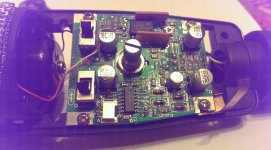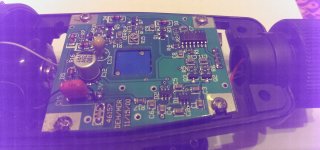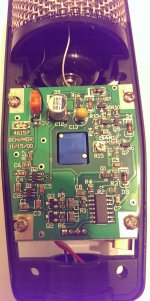Hi folks,
I'm not sure if this question is appropriate for this forum but here goes nothing..
My trusty CAD M179 LDC Microphone appears to have died on me. I'm not exactly sure what happened but it stopped working after pluggin in a cheap (and tightly fitting) xlr cable. I have got into the bad habit of not turning phantom power off and I'm guessing some sort of short was caused. I guess I've learnt the hard way there then!
Basically there is no output now.
I really like this mic and would like to explore the option of trying to find what needs to be fixed on it.
Having a look at various people offering such repair services seems to indicate that I may spend close to what I paid for it new.
If there is any advice anyone can give me on this (aside from don't use cheap XLR cables and hot plug!) I would be very grateful!
I have been inside very briefly hoping to see something very obviously burnt but to no avail. Its mainly surface mount small components which of course makes it tricky.
Perhaps it is it now just a paperweight?
Many thanks in advance for any insight that may be offered!
I'm not sure if this question is appropriate for this forum but here goes nothing..
My trusty CAD M179 LDC Microphone appears to have died on me. I'm not exactly sure what happened but it stopped working after pluggin in a cheap (and tightly fitting) xlr cable. I have got into the bad habit of not turning phantom power off and I'm guessing some sort of short was caused. I guess I've learnt the hard way there then!
Basically there is no output now.
I really like this mic and would like to explore the option of trying to find what needs to be fixed on it.
Having a look at various people offering such repair services seems to indicate that I may spend close to what I paid for it new.
If there is any advice anyone can give me on this (aside from don't use cheap XLR cables and hot plug!) I would be very grateful!
I have been inside very briefly hoping to see something very obviously burnt but to no avail. Its mainly surface mount small components which of course makes it tricky.
Perhaps it is it now just a paperweight?
Many thanks in advance for any insight that may be offered!
Attachments
I would check the phantom supply and cable first. A bad shield connection will kill the mic.
Then see if you get voltage to pin 14 of what appears to be IC1.
Then see if you get voltage to pin 14 of what appears to be IC1.
Moisture
Hello and thank you for you replies.
The pre channel is fine with other mics as far as I can tell.
I also checked the XLR pins and they have not been moved or damaged in any way.
I am not getting 48 volts at any of the legs on that IC.
This morning I sat with the mic plugged into a portable Tascam with headphones on trying the various pickup patterns to see if I could get any output.
As soon as I plugged the mic in it worked for a few seconds then there was a bump sound like phantom had been switched off and the signal cut out. After 20 seconds or so it came back. This seems to be the case wherever I am on the pickup pattern dial. It continually does this.
Could this be caused be moisture? It has been a bit humid recently and I recently found my dehumidifier was running to kick in at a higher level of humidity than normal. I must have knocked the switch by accident.
I am going to put the mic under a lamp and see what happens.
I kind of feel like there is some hope now to save it!
Any other thoughts or comments would be greatly appreciated!
Thank you!
Hello and thank you for you replies.
The pre channel is fine with other mics as far as I can tell.
I also checked the XLR pins and they have not been moved or damaged in any way.
I am not getting 48 volts at any of the legs on that IC.
This morning I sat with the mic plugged into a portable Tascam with headphones on trying the various pickup patterns to see if I could get any output.
As soon as I plugged the mic in it worked for a few seconds then there was a bump sound like phantom had been switched off and the signal cut out. After 20 seconds or so it came back. This seems to be the case wherever I am on the pickup pattern dial. It continually does this.
Could this be caused be moisture? It has been a bit humid recently and I recently found my dehumidifier was running to kick in at a higher level of humidity than normal. I must have knocked the switch by accident.
I am going to put the mic under a lamp and see what happens.
I kind of feel like there is some hope now to save it!
Any other thoughts or comments would be greatly appreciated!
Thank you!
More likely a broken/cracked solder joint or even a pc board trace crack. You said the problem started after wrestling with a stiff connector plugged into it. Not a stretch of the imagination to think the flexing and torque of trying to free the connector cracked some solder. Now and then the edges touch and it works briefly.
And are you in the USA? If nothing else contact CAD and see if they service that model. I have had success sending mics back to their makers in the past.
And are you in the USA? If nothing else contact CAD and see if they service that model. I have had success sending mics back to their makers in the past.
I would start by cleaning the board with KONTAKT PCC. It seems not to use exotic parts. Check the electrolytic caps, if they are bad they can load / short the phantom supply. The solder around the 60V marking and black wire looks suspicious. Can you measure some voltage on that 60v pin ? Try measuring phantom power with mic connected to test if mic shorts power. That white thing near the switch and screw.. is it a fuse a capacitor ... Check diodes also
Hi.
I'm having sort of the same issue with a CAD M179. I already "baked" it under under a cake-bell (made of plexiglass; leaf it exposed to direct sunlight for 10 minutes and usually it gets really hot under there). Today was kind of a cloudy day, so I will try this again tomorrow.
After "baking" and reassembling the mic I tried it out on my old Mackie 1202 mixer and it worked for about 4 minutes.
I will also try to clean the PCBs with alcohol.
Any other suggestions?
BTW: I usually don't turn off phantom power, either. Especially when I'm using several mics with phantom on a larger console. I just turn down the volume on the particular channel...
I'm having sort of the same issue with a CAD M179. I already "baked" it under under a cake-bell (made of plexiglass; leaf it exposed to direct sunlight for 10 minutes and usually it gets really hot under there). Today was kind of a cloudy day, so I will try this again tomorrow.
After "baking" and reassembling the mic I tried it out on my old Mackie 1202 mixer and it worked for about 4 minutes.
I will also try to clean the PCBs with alcohol.
Any other suggestions?
BTW: I usually don't turn off phantom power, either. Especially when I'm using several mics with phantom on a larger console. I just turn down the volume on the particular channel...
Pretty simple circuit, 6 transistors. should work out of the case.
What is the production date? Example in post 1 is year 2000. If yours is similar, check value & ESR of the e-caps. Or cheaper if you don't do this a lot, replace them.
Then trace out the circuit. See where the phantom power goes in, where the capsule puts the AC in. Trace the circuit. Pomona Grabbers may help you trace the signals.
What is the production date? Example in post 1 is year 2000. If yours is similar, check value & ESR of the e-caps. Or cheaper if you don't do this a lot, replace them.
Then trace out the circuit. See where the phantom power goes in, where the capsule puts the AC in. Trace the circuit. Pomona Grabbers may help you trace the signals.
According to the schematics M179-39 1+2, its actually 7 transistors (5x 3904, 2x 3906) and 3 op-amps (1x TLC072 dual, 1x MC33179 quad, 1x 4093A quad with only one used).
The problem is that its SMD in a small condenser mic (that equals really tight spaces), and I'm not so familiar with it.
The problem is that its SMD in a small condenser mic (that equals really tight spaces), and I'm not so familiar with it.
Just found it printed on the PCBs. Its Nov 15, 2000.
It also says "CAD 46157 (46158) DEH/MOR", so I guess the schematics I referred to are not exactly the ones that correspond to the M179.
It also says "CAD 46157 (46158) DEH/MOR", so I guess the schematics I referred to are not exactly the ones that correspond to the M179.
That date is the same as in the picture in post 1. So must be a design revision date, not a production date. Look at the code on the caps. Unfortunately the codes are 1 digit year plus 2 digit week now, as you are required to throw all electronic equipment away after 9 years.
That multi-leg thing might be a semiconductor IC instead of R2 as it is labeled, but I can't read the text on it.
FETs are a bit fragile IMHO. I'd look for transistors shorted from source to drain. Also poking with a meter probe with the power on and an AC detector on the output can sometimes find a bad solder joint. You'll have to have a sound source on, of course, for the latter. If the DC on the capsule comes & goes with the poking around, that is another detectable symptom.
That multi-leg thing might be a semiconductor IC instead of R2 as it is labeled, but I can't read the text on it.
FETs are a bit fragile IMHO. I'd look for transistors shorted from source to drain. Also poking with a meter probe with the power on and an AC detector on the output can sometimes find a bad solder joint. You'll have to have a sound source on, of course, for the latter. If the DC on the capsule comes & goes with the poking around, that is another detectable symptom.
- Status
- Not open for further replies.
- Home
- Live Sound
- PA Systems
- Troubleshooting a broken LDC Microphone


